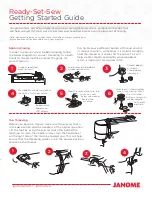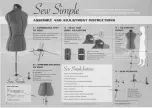
Adjusting
the
upper
thread
tension
6
The tension is created by the discs through which the thread is guided.
The pressure on these discs is controlled by the upper thread tension
regulator . The higher the number, the higher the tension.
thread tension discs
reduce
tension increase tension
An upper thread tension fo 3-4 is ideal for most sewing work.
The upper thread tension is not activated until the presser foot is lowered.
There are a number of reasons why you might need to adjust the tension.
For example, different tensions are required for different fabrics.
The tension you require depends on the strength and thickness of the fabric,
the number of layers of fabric you want to sew and the type of stitch you
choose. Please make sure that the tension of the upper and lower threads
match, as otherwise the fabric may gather. We recommend that you carry
out a test on a scrap of fabric before starting work.
Correct stitching
upper
thread
lower thread
lower fabric layer
upper fabric layer
As shown, the tension of the upper and lower thread
should be sufficient to ensure that the threads interlace
in the middle of the fabric. The fabric remains smooth
and does not pucker.
16
Incorrect
types
of
stitching
Incorrect
types
of
stitching
Upper
thread
is
too
tight and pulls the lower thread up.
The lower thread is visible on the upper fabric layer.
Solution:
Reduce the upper thread
tension by turning the
upper thread tension
regulator to a lower number.
reduce tension
Upper thread is too loose. The lower thread pulls the
upper thread down. The upper thread is visible on the
underside of the fabric layer.
Solution:
Increase the upper thread
tension by turning the upper
thread tension regulator to
a lower number.
increase tension
lower fabric layer
upper fabric layer
lower fabric layer
upper fabric layer
4
3
5
4
3
5
6
4
3
5








































